
Phonetics
.pdf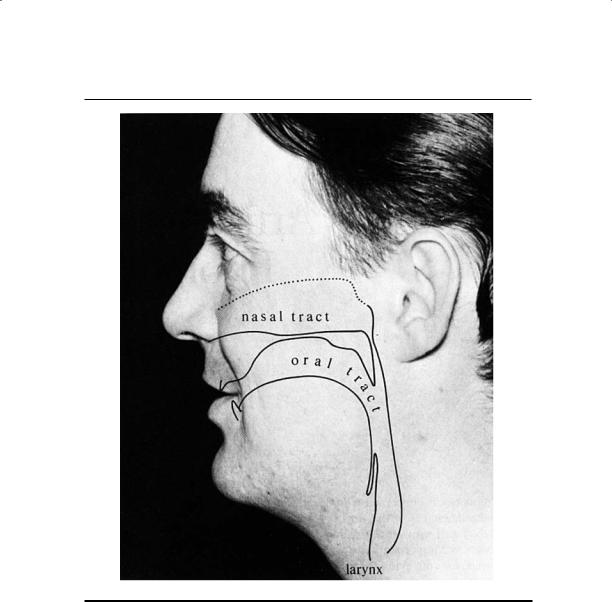
Speech Production |
5 |
Figure 1.2 The vocal tract.
the speech production mechanism as a whole. Figure 1.3 shows the four main components—the airstream process, the phonation process, the oro-nasal process, and the articulatory process. The airstream process includes all the ways of pushing air out (and, as we will see later, of sucking it in) that provide the power for speech. For the moment, we have considered just the respiratory system, the lungs pushing out air, as the prime mover in this process. The phonation process is the name given to the actions of the vocal folds. Only two possibilities have been mentioned: voiced sounds in which the vocal folds are vibrating and voiceless sounds in which they are apart. The possibility of the airstream going out through the mouth, as in [v] or [z], or the nose, as in [m] and [n], is determined by the oro-nasal process. The movements of the tongue and lips interacting with the roof of the mouth and the pharynx are part of the articulatory process.
Copyright 2010 Cengage Learning, Inc. All Rights Reserved. May not be copied, scanned, or duplicated, in whole or in part.
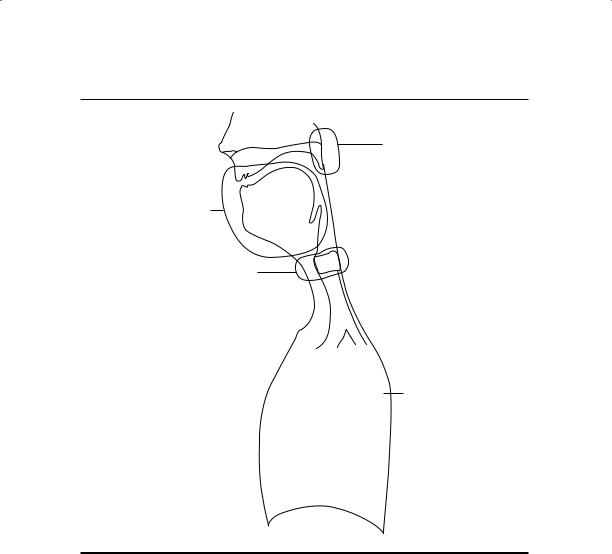
6CHAPTER 1 Articulation and Acoustics
Figure 1.3 The four main components of the speech mechanism.
oro-nasal process
articulatory process
phonation process
airstream process
SOUND WAVES
So far, we have been describing speech sounds by stating how they are made, but it is also possible to describe them in terms of what we can hear. The way in which we hear a sound depends on its acoustic structure. We want to be able to describe the acoustics of speech for many reasons (for more on acoustic phonetics, see Keith Johnson’s book Acoustic and Auditory Phonetics). Linguists and speech pathologists need to understand how certain sounds become confused with one another. We can give better descriptions of some sounds (such as vowels) by describing their acoustic structures rather than by describing the articulatory movements involved. A knowledge of acoustic phonetics is also helpful for understanding how computers synthesize speech and how speech recognition works (topics that are addressed more fully in Peter Ladefoged’s book Vowels and Consonants). Furthermore, often the only permanent data that we can get of a speech event is an audio recording, as it is often impossible to obtain movies or
Copyright 2010 Cengage Learning, Inc. All Rights Reserved. May not be copied, scanned, or duplicated, in whole or in part.

Sound Waves |
7 |
x-rays showing what the speaker is doing. Accordingly, if we want permanent data that we can study, it will often have to come from analyzing an audio recording.
Speech sounds, like other sounds, can differ from one another in three ways. They can be the same or different in (1) pitch, (2) loudness, and (3) quality. Thus, two vowel sounds may have exactly the same pitch in the sense that they are said on the same note on the musical scale, and they may have the same loudness, yet still may differ in that one might be the vowel in bad and the other the vowel in bud. On the other hand, they might have the same vowel quality but differ in that one was said on a higher pitch or that one of them was spoken more loudly.
Sound consists of small variations in air pressure that occur very rapidly one after another. These variations are caused by actions of the speaker’s vocal organs that are (for the most part) superimposed on the outgoing flow of lung air. Thus, in the case of voiced sounds, the vibrating vocal folds chop up the stream of lung air so that pulses of relatively high pressure alternate with moments of lower pressure. Variations in air pressure in the form of sound waves move through the air somewhat like the ripples on a pond. When they reach the ear of a listener, they cause the eardrum to vibrate. A graph of a sound wave is very similar to a graph of the movements of the eardrum.
The upper part of Figure 1.4 shows the variations in air pressure that occur during Peter Ladefoged’s pronunciation of the word father. The ordinate (the vertical axis) represents air pressure (relative to the normal surrounding air pressure), and the abscissa (the horizontal axis) represents time (relative to an arbitrary starting point). As you can see, this particular word took about 0.6 seconds to say. The lower part of the figure shows part of the first vowel in father. The major peaks in air pressure recur about every 0.01 seconds (that is, every onehundredth of a second). This is because the vocal folds were vibrating approximately one hundred times a second, producing a pulse of air every hundredth of a second. This part of the diagram shows the air pressure corresponding to four vibrations of the vocal folds. The smaller variations in air pressure that occur within each period of one-hundredth of a second are due to the way air vibrates when the vocal tract has the particular shape required for this vowel.
In the upper part of Figure 1.4, which shows the waveform for the whole word father, the details of the variations in air pressure are not visible because the time scale is too compressed. All that can be seen are the near-vertical lines corresponding to the individual pulses of the vocal folds. The sound [ f ] at the beginning of the word father has a low amplitude (it is not very loud, so the pressure fluctuation is not much different from zero) in comparison with the following vowel, and the variations in air pressure are smaller and more nearly random. There are no regular pulses because the vocal folds are not vibrating. We will be considering waveforms and their acoustic analysis in more detail later in this book. For the moment, we will simply notice the obvious difference between sounds in which the vocal folds are vibrating (which have comparatively large regular pulses of air pressure) and sounds without vocal fold vibration (which have a smaller amplitude and irregular variations in air pressure).
Copyright 2010 Cengage Learning, Inc. All Rights Reserved. May not be copied, scanned, or duplicated, in whole or in part.
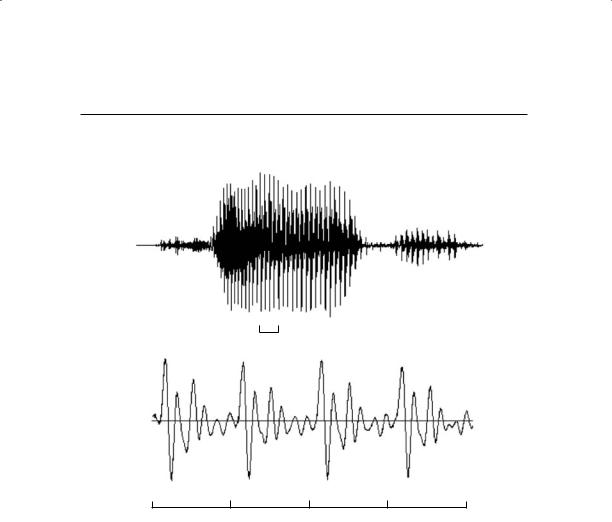
8CHAPTER 1 Articulation and Acoustics
Figure 1.4 The variations in air pressure that occur during Peter Ladefoged’s pronunciation of the vowel in father.
0.0 |
0.2 |
0.4 |
0.6 s |
||||
|
|
|
|
|
|
|
|
|
|
|
|
|
|
|
|
|
f |
|
a |
|
th |
er |
|
this |
part |
expanded |
expanded |
|
|
0.0 |
0.01 |
0.02 |
0.03 |
0.04 s |
|
|
|
|
|
PLACES OF ARTICULATORY GESTURES
The parts of the vocal tract that can be used to form sounds are called articulators. The articulators that form the lower surface of the vocal tract are highly mobile. They make the gestures required for speech by moving toward the articulators that form the upper surface. Try saying the word capital and note the major movements of your tongue and lips. You will find that the back of the tongue moves up to make contact with the roof of the mouth for the first sound and then comes down for the following vowel. The lips come together in the formation of p and then come apart again in the vowel. The tongue tip comes up for the t and again, for most people, for the final l.
The names of the principal parts of the upper surface of the vocal tract are given in Figure 1.5. The upper lip and the upper teeth (notably the frontal incisors) are familiar-enough structures. Just behind the upper teeth is a small protuberance that you can feel with the tip of the tongue. This is called the alveolar ridge. You can also feel that the front part of the roof of the mouth is formed
Copyright 2010 Cengage Learning, Inc. All Rights Reserved. May not be copied, scanned, or duplicated, in whole or in part.

Places of Articulatory Gestures |
9 |
Figure 1.5 The principal parts of the upper surface of the vocal tract.
by a bony structure. This is the hard palate. You will probably have to use a fingertip to feel farther back. Most people cannot curl the tongue up far enough to touch the soft palate, or velum, at the back of the mouth. The soft palate is a muscular flap that can be raised to press against the back wall of the pharynx and shut off the nasal tract, preventing air from going out through the nose. In this case, there is said to be a velic closure. This action separates the nasal tract from the oral tract so that the air can go out only through the mouth. At the lower end of the soft palate is a small appendage hanging down that is known as the uvula. The part of the vocal tract between the uvula and the larynx is the pharynx. The back wall of the pharynx may be considered one of the articulators on the upper surface of the vocal tract.
Figure 1.6 shows the lower lip and the specific names for the parts of the tongue that form the lower surface of the vocal tract. The tip and blade of the tongue are the most mobile parts. Behind the blade is what is technically called the front of the tongue; it is actually the forward part of the body of the tongue and lies underneath the hard palate when the tongue is at rest. The remainder of the body of the tongue may be divided into the center, which is partly beneath the hard palate and partly beneath the soft palate; the back, which is beneath the soft palate; and the root, which is opposite the back wall of the pharynx. The epiglottis is attached to the lower part of the root of the tongue.
Bearing all these terms in mind, say the word peculiar and try to give a rough description of the gestures made by the vocal organs during the consonant sounds. You should find that the lips come together for the first sound. Then the back and center of the tongue are raised. But is the contact on the hard palate or on the velum? (For most people, it is centered between the two.) Then note the position in the formation of the l. Most people make this sound with the tip of the tongue on the alveolar ridge.
Copyright 2010 Cengage Learning, Inc. All Rights Reserved. May not be copied, scanned, or duplicated, in whole or in part.
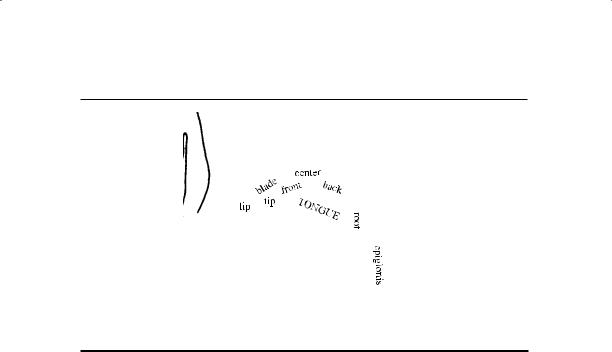
10CHAPTER 1 Articulation and Acoustics
Figure 1.6 The principal parts of the lower surface of the vocal tract.
Now compare the words true and tea. In which word does the tongue movement involve a contact farther forward in the mouth? Most people make contact with the tip or blade of the tongue on the alveolar ridge when saying tea, but slightly farther back in true. Try to distinguish the differences in other consonant sounds, such as those in sigh and shy and those at the beginning of fee and thief.
When considering diagrams such as those we have been discussing, it is important to remember that they show only two dimensions. The vocal tract is a tube, and the positions of the sides of the tongue may be very different from the position of the center. In saying sigh, for example, there is a deep hollow in the center of the tongue that is not present when saying shy. We cannot represent this difference in a two-dimensional diagram that shows just the midline of the tongue—a so-called mid-sagittal view. We will be relying on mid-sagittal diagrams of the vocal organs to a considerable extent in this book. But we should never let this simplified view become the sole basis for our conceptualization of speech sounds.
In order to form consonants, the airstream through the vocal tract must be obstructed in some way. Consonants can be classified according to the place and manner of this obstruction. The primary articulators that can cause an obstruction in most languages are the lips, the tongue tip and blade, and the back of the tongue. Speech gestures using the lips are called labial articulations; those using the tip or blade of the tongue are called coronal articulations; and those using the back of the tongue are called dorsal articulations.
If we do not need to specify the place of articulation in great detail, then the articulators for the consonants of English (and of many other languages) can be described using these terms. The word topic, for example, begins with a coronal
Copyright 2010 Cengage Learning, Inc. All Rights Reserved. May not be copied, scanned, or duplicated, in whole or in part.
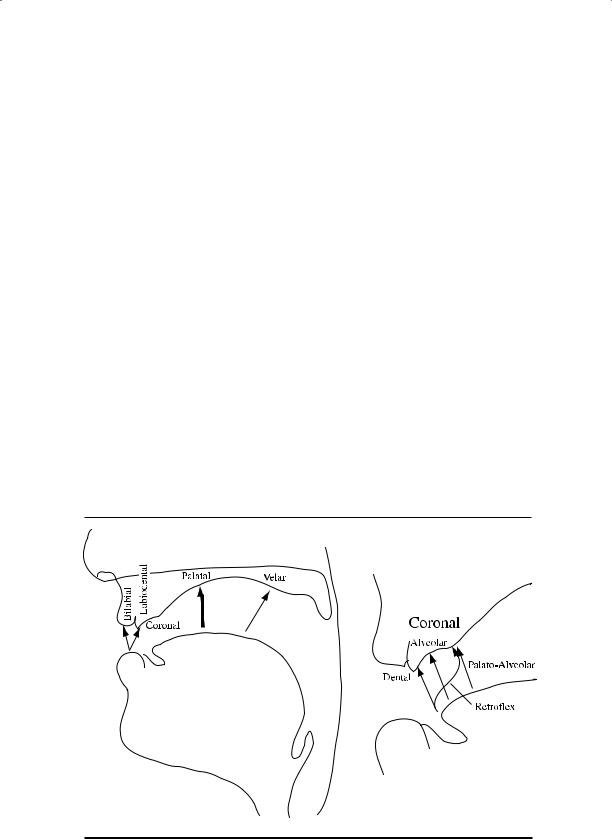
Places of Articulatory Gestures |
11 |
consonant; in the middle is a labial consonant; and at the end a dorsal consonant. Check this by feeling that the tip or blade of your tongue is raised for the first (coronal) consonant, your lips close for the second (labial) consonant, and the back of your tongue is raised for the final (dorsal) consonant.
These terms, however, do not specify articulatory gestures in sufficient detail for many phonetic purposes. We need to know more than which articulator is making the gesture, which is what the terms labial, coronal, and dorsal tell us. We also need to know what part of the upper vocal tract is involved. More specific places of articulation are indicated by the arrows going from one of the lower articulators to one of the upper articulators in Figure 1.7. Because there are so many possibilities in the coronal region, this area is shown in more detail at the right of the figure. The principal terms for the particular types of obstruction required in the description of English are as follows.
1.Bilabial
(Made with the two lips.) Say words such as pie, buy, my and note how the lips come together for the first sound in each of these words. Find a comparable set of words with bilabial sounds at the end.
2.Labiodental
(Lower lip and upper front teeth.) Most people, when saying words such as fie and vie, raise the lower lip until it nearly touches the upper front teeth.
Figure 1.7 A sagittal section of the vocal tract, showing the places of articulation that occur in English. The coronal region is shown in more detail at the right.
Copyright 2010 Cengage Learning, Inc. All Rights Reserved. May not be copied, scanned, or duplicated, in whole or in part.

12CHAPTER 1 Articulation and Acoustics
3.Dental
(Tongue tip or blade and upper front teeth.) Say the words thigh, thy. Some people (most speakers of American English as spoken in the Midwest and on the West Coast) have the tip of the tongue protruding between the upper and lower front teeth; others (most speakers of British English) have it close behind the upper front teeth. Both sounds are normal in English, and both may be called dental. If a distinction is needed, sounds in which the tongue protrudes between the teeth may be called interdental.
4.Alveolar
(Tongue tip or blade and the alveolar ridge.) Again there are two possibilities in English, and you should find out which you use. You may pronounce words such as tie, die, nigh, sigh, zeal, lie using the tip of the tongue or the blade of the tongue. You may use the tip of the tongue for some of these words and the blade for others. For example, some people pronounce [ s ] with the tongue tip tucked behind the lower teeth, producing the constriction at the alveolar ridge with the blade of the tongue; others have the tongue tip up for [ s ]. Feel how you normally make the alveolar consonants in each of these words, and then try to make them in the other way. A good way to appreciate the difference between dental and alveolar sounds is to say ten and tenth (or n and nth). Which n is farther back? (Most people make the one in ten on the alveolar ridge and the one in tenth as a dental sound with the tongue touching the upper front teeth.)
5.Retroflex
(Tongue tip and the back of the alveolar ridge.) Many speakers of English do not use retroflex sounds at all. But some speakers begin words such as rye, row, ray with retroflex sounds. Note the position of the tip of your tongue in these words. Speakers who pronounce r at the ends of words may also have retroflex sounds with the tip of the tongue raised in ire, hour, air.
6.Palato-Alveolar
(Tongue blade and the back of the alveolar ridge.) Say words such as shy, she, show. During the consonants, the tip of your tongue may be down behind the lower front teeth or up near the alveolar ridge, but the blade of the tongue is always close to the back part of the alveolar ridge. Because these sounds are made farther back in the mouth than those in sigh, sea, sew, they can also be called post-alveolar. You should be able to pronounce them with the tip or blade of the tongue. Try saying shipshape with your tongue tip up on one occasion and down on another. Note that the blade of the tongue will always be raised. You may be able to feel the
Copyright 2010 Cengage Learning, Inc. All Rights Reserved. May not be copied, scanned, or duplicated, in whole or in part.

The Oro-Nasal Process |
13 |
place of articulation more distinctly if you hold the position while taking in a breath through the mouth. The incoming air cools the region where there is greatest narrowing, the blade of the tongue and the back part of the alveolar ridge.
7.Palatal
(Front of the tongue and hard palate.) Say the word you very slowly so that you can isolate the consonant at the beginning. If you say this consonant by itself, you should be able to feel that it begins with the front of the tongue raised toward the hard palate. Try to hold the beginning consonant position and breathe in through the mouth. You will probably be able to feel the rush of cold air between the front of the tongue and the hard palate.
8.Velar
(Back of the tongue and soft palate.) The consonants that have the place of articulation farthest back in English are those that occur at the end of hack, hag, hang. In all these sounds, the back of the tongue is raised so that it touches the velum.
As you can tell from the descriptions of these articulatory gestures, the first two, bilabial and labiodental, can be classified as labial, involving at least the lower lip; the next four—dental, alveolar, retroflex, and palato-alveolar (post- alveolar)—are coronal articulations, with the tip or blade of the tongue raised; and the last, velar, is a dorsal articulation, using the back of the tongue. Palatal sounds are sometimes classified as coronal articulations and sometimes as dorsal articulations, a point to which we shall return.
To get the feeling of different places of articulation, consider the consonant at the beginning of each of the following words: fee, theme, see, she. Say these consonants by themselves. Are they voiced or voiceless? Now note that the place of articulation moves back in the mouth in making this series of voiceless consonants, going from labiodental, through dental and alveolar, to palato-alveolar.
THE ORO-NASAL PROCESS
Consider the consonants at the ends of rang, ran, ram. When you say these consonants by themselves, note that the air is coming out through the nose. In the formation of these sounds in sequence, the point of articulatory closure moves forward, from velar in rang, through alveolar in ran, to bilabial in ram. In each case, the air is prevented from going out through the mouth but is able to go out through the nose because the soft palate, or velum, is lowered.
In most speech, the soft palate is raised so that there is a velic closure. When it is lowered and there is an obstruction in the mouth, we say that there is a nasal consonant. Raising or lowering the velum controls the oro-nasal process, the distinguishing factor between oral and nasal sounds.
Copyright 2010 Cengage Learning, Inc. All Rights Reserved. May not be copied, scanned, or duplicated, in whole or in part.

14 |
CHAPTER 1 Articulation and Acoustics |
MANNERS OF ARTICULATION
At most places of articulation, there are several basic ways in which articulatory gestures can be accomplished. The articulators may close off the oral tract for an instant or a relatively long period; they may narrow the space considerably; or they may simply modify the shape of the tract by approaching each other.
Stop
(Complete closure of the articulators involved so that the airstream cannot escape through the mouth.) There are two possible types of stop.
Oral stop If, in addition to the articulatory closure in the mouth, the soft palate is raised so that the nasal tract is blocked off, then the airstream will be completely obstructed. Pressure in the mouth will build up and an oral stop will be formed. When the articulators come apart, the airstream will be released in a small burst of sound. This kind of sound occurs in the consonants in the words pie, buy (bilabial closure), tie, dye (alveolar closure), and kye, guy (velar closure). Figure 1.8 shows the positions of the vocal organs in the bilabial stop in buy. These sounds are called plosives in the International Phonetic Association’s (IPA’s) alphabet (see inside the front cover of this book).
Nasal stop If the air is stopped in the oral cavity but the soft palate is down so that air can go out through the nose, the sound produced is a nasal stop. Sounds of this kind occur at the beginning of the words my (bilabial closure) and nigh (alveolar closure), and at the end of the word sang (velar closure). Figure 1.9 shows the position of the vocal organs during the bilabial nasal stop in my. Apart from the presence of a velic opening, there is no difference between this stop and the one in buy shown in Figure 1.8. Although both the nasal sounds and the oral sounds can be classified as stops, the term stop by itself is almost always used by phoneticians to indicate an oral stop, and the term nasal to indicate a nasal stop. Thus, the consonants at the beginnings of the words day and neigh would be called an alveolar stop and an alveolar nasal, respectively. Although the term stop may be defined so that it applies only to the prevention of air escaping through the mouth, it is commonly used to imply a complete stoppage of the airflow through both the nose and the mouth.
Fricative
(Close approximation of two articulators so that the airstream is partially obstructed and turbulent airflow is produced.) The mechanism involved in making these slightly hissing sounds may be likened to that involved when the wind whistles around a corner. The consonants in fie, vie (labiodental), thigh, thy (dental), sigh, zoo (alveolar), and shy (palato-alveolar) are examples of fricative sounds. Figure 1.10 illustrates one pronunciation of the palato-alveolar fricative consonant in shy. Note the narrowing of the vocal tract between the blade of the
Copyright 2010 Cengage Learning, Inc. All Rights Reserved. May not be copied, scanned, or duplicated, in whole or in part.
